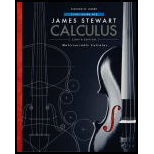
Study Guide for Stewart's Multivariable Calculus, 8th
8th Edition
ISBN: 9781305271845
Author: Stewart, James
Publisher: Brooks Cole
expand_more
expand_more
format_list_bulleted
Concept explainers
Question
Chapter 11.1, Problem 3PT
To determine
The given statement occurs sometimes, always or never.
Expert Solution & Answer
Trending nowThis is a popular solution!

Students have asked these similar questions
Give an example in which {an} ∞ n=1 and {bn} ∞ n=1 do not converge but {an + bn} ∞ n=1 converges.
Determine whether each statement is true or false. If the statement is true, prove it.
If the statement is false, provide a counter-example or other justification.
(a) If {lanl} converges, then {a,} converges.
(b) If {a} converges, then {an} converges.
(c) If {an + bn} converges, then {an} and {bn} both converge.
(d) If {an + bn} and {an} both converge, then {bn} converges.
If 2n=1a, converges, and if a„ # 1 and a,n > 0 for all n,
a. Show that E=1a, converges.
b. Does E-1a,n/(1 – a„) converge? Explain.
Chapter 11 Solutions
Study Guide for Stewart's Multivariable Calculus, 8th
Ch. 11.1 - limnn2+3n2n2+n+1= a) 0 b) 12 c) 1 d)Ch. 11.1 - Prob. 2PTCh. 11.1 - Prob. 3PTCh. 11.1 - Sometimes, Always, or Never: If {an} is increasing...Ch. 11.1 - Prob. 5PTCh. 11.1 - Prob. 6PTCh. 11.1 - Prob. 7PTCh. 11.1 - Prob. 8PTCh. 11.2 - Prob. 1PTCh. 11.2 - Prob. 2PT
Ch. 11.2 - Prob. 3PTCh. 11.2 - Prob. 4PTCh. 11.2 - Prob. 5PTCh. 11.2 - Prob. 6PTCh. 11.2 - Prob. 7PTCh. 11.2 - Prob. 8PTCh. 11.3 - For what values of p does the series n=11(n2)p...Ch. 11.3 - True or False: If f(x) is continuous and...Ch. 11.3 - Prob. 3PTCh. 11.3 - Prob. 4PTCh. 11.3 - Prob. 5PTCh. 11.3 - Prob. 6PTCh. 11.4 - Prob. 1PTCh. 11.4 - Prob. 2PTCh. 11.4 - True or False: n=1n+n3n2/3+n3/2+1 is a convergent...Ch. 11.4 - Prob. 4PTCh. 11.4 - Prob. 5PTCh. 11.5 - Prob. 1PTCh. 11.5 - Prob. 2PTCh. 11.5 - Prob. 3PTCh. 11.5 - Prob. 4PTCh. 11.6 - Prob. 1PTCh. 11.6 - Prob. 2PTCh. 11.6 - Prob. 3PTCh. 11.6 - Prob. 4PTCh. 11.6 - Prob. 5PTCh. 11.6 - Prob. 6PTCh. 11.7 - Prob. 1PTCh. 11.7 - Prob. 2PTCh. 11.7 - Prob. 3PTCh. 11.7 - Prob. 4PTCh. 11.7 - Prob. 5PTCh. 11.7 - Prob. 6PTCh. 11.8 - Sometimes, Always, or Never: The interval of...Ch. 11.8 - Prob. 2PTCh. 11.8 - Prob. 3PTCh. 11.8 - Prob. 4PTCh. 11.8 - Prob. 5PTCh. 11.9 - Prob. 1PTCh. 11.9 - For f(x)=n=0x2nn!, f(x) = a) n=1x2n1n! b)...Ch. 11.9 - Using 11x=n=0xn for |x| 1, x1x2dx= a) n=0x2n2n b)...Ch. 11.9 - Using 11x=n=0xn for |x| 1 and differentiation,...Ch. 11.9 - From 11x=n=0xn for |x| 1 and substituting 4x2 for...Ch. 11.10 - Given the Taylor Series ex=n=0xnn!, a Taylor...Ch. 11.10 - Prob. 2PTCh. 11.10 - Prob. 3PTCh. 11.10 - Prob. 4PTCh. 11.10 - Prob. 5PTCh. 11.10 - Prob. 6PTCh. 11.10 - Prob. 7PTCh. 11.10 - Prob. 8PTCh. 11.10 - Prob. 9PTCh. 11.10 - Prob. 10PTCh. 11.10 - Using a binomial series, the Maclaurin series for...Ch. 11.10 - Prob. 12PTCh. 11.11 - Prob. 1PTCh. 11.11 - Prob. 2PTCh. 11.11 - Prob. 3PT
Knowledge Booster
Learn more about
Need a deep-dive on the concept behind this application? Look no further. Learn more about this topic, calculus and related others by exploring similar questions and additional content below.Similar questions
- Do the following: (a) Give an example of two divergent sequences (an) and (bn) for which (an + bn) converges. (b) Give an example of two divergent sequences (an) and (bn) for which (an · bn) converges. (c) Is is possible for a sequence (an) to converge, a sequence (bn) to diverge, and for (an + bn) to converge? If so, give an example; if not, justify your answer with a proof.arrow_forward2n Let an = Зп + 1 (a) Determine whether {a,} is convergent. (b) Determine whether>an is convergent.arrow_forwardan always converges. bn If two positive sequences {a„} and {b,} converge, then the sequence Select one: O True O Falsearrow_forward
- Let a and b be positive numbers with a>b. Let a1 be their arithmetic mean and b1 their geometric mean. a1 = a+b/2 b1 = √ab Repeat this process so that, in general, an+1= an+bn/2 bn+1= √ab (a) Use mathematical induction to show that an>an+a>bn+1>bn (b) Deduce that both {an} and {bn} are convergent. (c) show that limn-->infinity an = limn-->infinity bn. Guass call the commone value of thes limits the arithmetic-geometric mean of the numvers a and b.arrow_forwardlution: 2) If a, = (1+-)", {a,}is convergent. show that the %3D n 1)arrow_forwardIf an > 0 and an converges, then (-1)"an converges. Select one: O True O Falsearrow_forward
arrow_back_ios
arrow_forward_ios
Recommended textbooks for you
- Algebra & Trigonometry with Analytic GeometryAlgebraISBN:9781133382119Author:SwokowskiPublisher:Cengage

Algebra & Trigonometry with Analytic Geometry
Algebra
ISBN:9781133382119
Author:Swokowski
Publisher:Cengage
Sequences and Series Introduction; Author: Mario's Math Tutoring;https://www.youtube.com/watch?v=m5Yn4BdpOV0;License: Standard YouTube License, CC-BY
Introduction to sequences; Author: Dr. Trefor Bazett;https://www.youtube.com/watch?v=VG9ft4_dK24;License: Standard YouTube License, CC-BY